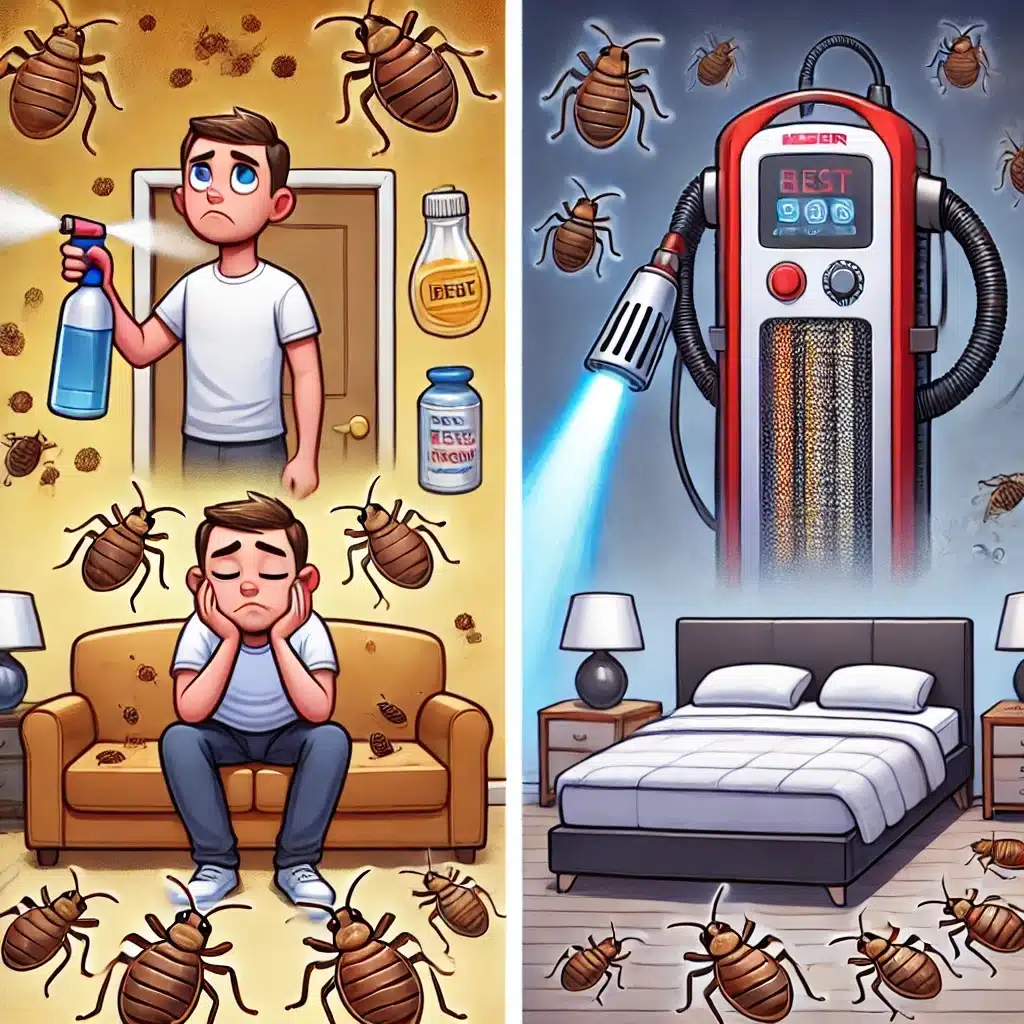By ThermoPest – Your Local Pest Control Experts
When it comes to bed bugs, there are plenty of rumours and myths floating around. Whether it’s horror stories from a friend or misinformation picked up online, it can be tricky to separate fact from fiction. Unfortunately, believing in these myths can lead to unnecessary panic or worse, taking the wrong steps to get rid of bed bugs.
At ThermoPest, we’ve seen and heard it all, and we’re here to set the record straight. Let’s take a closer look at some of the most common bed bug myths—and the real facts behind them.

Myth 1: Bed Bugs Only Infest Dirty Homes
Fact: Bed bugs don’t care whether your home is spotless or in need of a good scrub. They’re attracted to warmth and carbon dioxide they’re after your body heat and the air you breathe out, not crumbs on the carpet. Even the cleanest homes can end up with bed bugs if they’ve hitched a ride in from somewhere else.
Ever been on holiday, stayed in a lovely hotel, and brought a few extra guests home in your suitcase? It’s more common than you’d think. Bed bugs are master hitchhikers, often finding their way into homes through luggage, used furniture, or even public transport.
So, if you’ve got bed bugs, it’s not a reflection on your cleaning habits!
Myth 2: Bed Bugs Spread Disease
Fact: Let’s get one thing straight—bed bugs are annoying and itchy, but they’re not known to spread diseases. Unlike mosquitoes or ticks, bed bugs don’t transmit illnesses through their bites. That said, the bites can cause allergic reactions, and scratching them can lead to skin infections.
On top of that, bed bug infestations can have a real impact on your mental health. Many people experience anxiety, insomnia, and stress when they’re dealing with these pests. No one enjoys the idea of sharing their bed with unwanted visitors, and that can seriously mess with your peace of mind.
Myth 3: Throwing Away Your Mattress Will Get Rid of Bed Bugs
Fact: If only it were that simple! While bed bugs do love hiding in mattresses, they’re not limited to just one spot. Bed bugs can also live in other furniture, carpets, curtains, and even in the cracks of your walls. Throwing away your mattress might help a little, but it won’t solve the problem.
A proper bed bug treatment involves targeting all areas where they might be hiding. Heat treatments, for example, are highly effective because they penetrate deep into all the places bed bugs like to hide—not just your bed. So, before you start tossing your furniture, remember that professional pest control is key to getting rid of these pests for good.
Myth 4: Bed Bugs Only Come Out at Night
Fact: While it’s true that bed bugs are more active at night (since they tend to feed when you’re asleep), they’re not strictly nocturnal. Bed bugs are opportunistic and will feed whenever they get the chance. If you’re napping during the day, don’t be surprised if they take the opportunity to have a snack.
These pests are expert hiders, so during the day, they’ll tuck themselves away in the crevices of your furniture, behind skirting boards, or in the seams of your mattress. But the moment they sense that you’re still and quiet, they’ll come out for a meal—whether it’s day or night.
Myth 5: Bed Bugs Are Too Small to Be Seen
Fact: Bed bugs are visible to the naked eye—you just need to know what you’re looking for. Adult bed bugs are about the size of an apple seed, with a reddish-brown colour and an oval-shaped body. They’re not microscopic, though they are good at hiding, which can make them tricky to spot.
You might first notice signs of bed bugs before actually seeing them. Look out for dark spots on your mattress (which are their droppings), small bloodstains on your sheets, or tiny eggs. If you’re waking up with bites and itching, it’s time to do a thorough check.
Myth 6: DIY Methods Are Always Effective
Fact: We’ve all heard about DIY remedies—vinegar, essential oils, and various homemade sprays. But the truth is, while some of these methods might kill a few bed bugs on contact, they won’t solve the problem. Bed bugs are notoriously tough, and home remedies often fail to reach all the places where they hide.
Bed bugs can survive for months without feeding, which means they can outlast most DIY efforts. That’s why professional pest control is so important. With advanced treatments like heat or targeted chemical solutions, you can be sure that all the bed bugs—and their eggs—are properly eliminated.

Wrapping Up: Separating Bed Bug Myths from Facts
When it comes to bed bugs, there’s no shortage of myths out there. But the truth is, bed bugs can infest any home, regardless of how clean it is, and they don’t just live in your mattress. While they’re not known to spread diseases, the bites and the stress that comes with an infestation can still be harmful to your health. And let’s face it—DIY treatments rarely do the job.
At ThermoPest, we’re all about facts. If you’re dealing with a bed bug problem, we’ve got the tools, expertise, and experience to help. Contact us today, and let’s get your home back to being bed bug-free!
